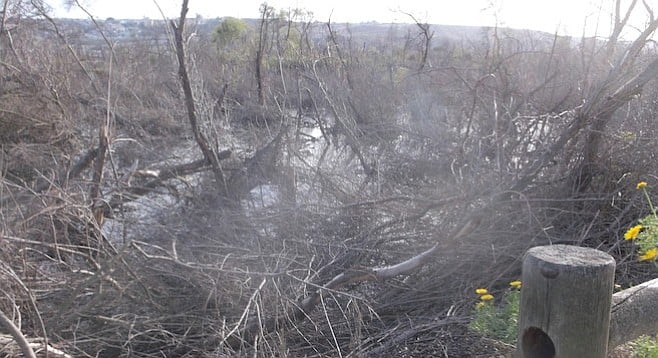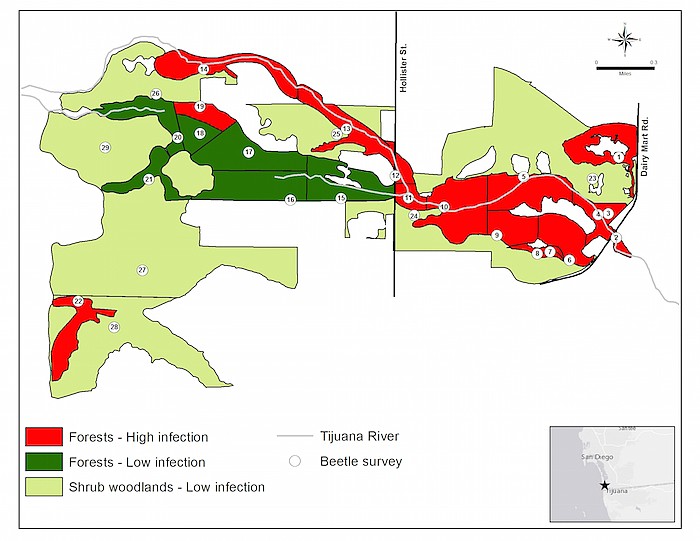 Facebook
Facebook
 X
X
 Instagram
Instagram
 TikTok
TikTok
 Youtube
Youtube

The devastation — 140,000 trees destroyed by a beetle infestation — that has beset the Tijuana River Valley is becoming the statewide symbol of what could happen if there isn't a rush to find ways to control the beetle.
Riparian biologist John Boland estimates that 75 percent of the California willows in the 1500 acres from the I-5 to the ocean between Imperial Beach and the border are badly infested with the Kuroshio shot hole borer beetle.
"The trees are completely naive to this kind of attack," Boland says. "They are familiar with flooding and thrive under those conditions. But they have never faced an enemy like this beetle."
In a statewide teleconference Tuesday (March 15) led by Santa Clara County's agriculture commissioner, the horror of the damage came up again and again.
"We need to utilize the visual impact of the damage in the Tijuana River Valley to show people that we stand to lose much greater resources than we thought," Joe Deviney said. "There's a tremendous impact outside of avocados."
The river valley trees that are still standing are broken and continue to drop limbs. The area along the river bed looks like it was hit from the sky by a giant weed-whacker. The broken wood lands in the river, where it dams the water flow; or on the trails, a public safety problem.
"We want to move it for public safety but we can't move it too far," says Jessica Geiszler, a county parks department spokeswoman. "We are working closely with our partner agencies so we can keep the beetle from spreading."

Maps of the Tijuana River Valley's wild lands, with the county park on the eastern edge, now show that the areas closest to the Tijuana River are fully infested, while drier areas nearby are somewhat infested. A few areas show no infestation, mainly because they don't have trees, Boland says. But at a recent meeting of the Tijuana River Recovery Team, composed of groups and government agencies in the U.S. and Mexico, a woman from Mexico approached Boland and showed him pictures of damaged trees in the Las Playas area of Tijuana, Boland says. He visited the area and confirmed that the beetles are there, on the south end of Yogurt Canyon, about a quarter mile from the beach.
The bugs are from Southeast Asia and resemble several other types of borer beetles, distinguished by DNA testing. They damage trees two ways: by boring holes through the trees and by farming the fungus they live on inside the tunnels. The fungus is deadly to the trees.
The Kuroshio beetle first showed up at the Sycuan Singing Hills Golf Course (where they killed dozens of old growth sycamores) and in northeastern San Diego County avocado groves.
So far, all the research on the bug — especially on how to contain it — has been paid for by the California Avocado Commission. The avocado group engaged Akif Eskalen of the University of California Riverside to track and study the bug and his researchers were focused on avocados until September 2015, when a San Diego area environmental consultant sent him pictures of damaged trees in the Tijuana River Valley.
After inspecting the area, which was already badly damaged, Eskalen concluded that the beetle had been active in the valley, along the river from Dairy Mart Road to the Hollister Street bridge, for at least a year. Avocado growers may be onto chemicals to control the beetle, Tim Spann said. But chemicals can't be used in the riparian forests, where the beetle is now far more prevalent.
The valley infestation means trouble for the endangered least Bell’d vireo, a bird that makes its home in the California native willows in the infestation zone.
"The population will decline and their productivity will decline because they won't have as many resources as the trees die," Boland says. "The least Bell’ vireo is going to have to make do with the shrubby plants that remain."
So far, county staff from the Department of Park and Recreation's open space have taken down about 2000 trees. The trees have been chipped and covered with tarps because moving the wood spreads the beetles. "We must quarantine our site, and both the city and the county are working on that," Boland says.
But it may be late: the beetle has also turned up in Balboa Park. No one is sure how it is being spread from Escondido to the river valley to central San Diego, though Boland suspects it may be the green recycling industry — intentionally and unknowingly, of course.
As horrible as the devastation appears, it's not clear that the trees are dead, Boland says. "It's very difficult to tell if a tree has been killed," he says. "Many of the trees have actually been sending up shoots…. The trunk they are growing on is absolutely riddled with holes and may not be able to support new growth."


The devastation — 140,000 trees destroyed by a beetle infestation — that has beset the Tijuana River Valley is becoming the statewide symbol of what could happen if there isn't a rush to find ways to control the beetle.
Riparian biologist John Boland estimates that 75 percent of the California willows in the 1500 acres from the I-5 to the ocean between Imperial Beach and the border are badly infested with the Kuroshio shot hole borer beetle.
"The trees are completely naive to this kind of attack," Boland says. "They are familiar with flooding and thrive under those conditions. But they have never faced an enemy like this beetle."
In a statewide teleconference Tuesday (March 15) led by Santa Clara County's agriculture commissioner, the horror of the damage came up again and again.
"We need to utilize the visual impact of the damage in the Tijuana River Valley to show people that we stand to lose much greater resources than we thought," Joe Deviney said. "There's a tremendous impact outside of avocados."
The river valley trees that are still standing are broken and continue to drop limbs. The area along the river bed looks like it was hit from the sky by a giant weed-whacker. The broken wood lands in the river, where it dams the water flow; or on the trails, a public safety problem.
"We want to move it for public safety but we can't move it too far," says Jessica Geiszler, a county parks department spokeswoman. "We are working closely with our partner agencies so we can keep the beetle from spreading."

Maps of the Tijuana River Valley's wild lands, with the county park on the eastern edge, now show that the areas closest to the Tijuana River are fully infested, while drier areas nearby are somewhat infested. A few areas show no infestation, mainly because they don't have trees, Boland says. But at a recent meeting of the Tijuana River Recovery Team, composed of groups and government agencies in the U.S. and Mexico, a woman from Mexico approached Boland and showed him pictures of damaged trees in the Las Playas area of Tijuana, Boland says. He visited the area and confirmed that the beetles are there, on the south end of Yogurt Canyon, about a quarter mile from the beach.
The bugs are from Southeast Asia and resemble several other types of borer beetles, distinguished by DNA testing. They damage trees two ways: by boring holes through the trees and by farming the fungus they live on inside the tunnels. The fungus is deadly to the trees.
The Kuroshio beetle first showed up at the Sycuan Singing Hills Golf Course (where they killed dozens of old growth sycamores) and in northeastern San Diego County avocado groves.
So far, all the research on the bug — especially on how to contain it — has been paid for by the California Avocado Commission. The avocado group engaged Akif Eskalen of the University of California Riverside to track and study the bug and his researchers were focused on avocados until September 2015, when a San Diego area environmental consultant sent him pictures of damaged trees in the Tijuana River Valley.
After inspecting the area, which was already badly damaged, Eskalen concluded that the beetle had been active in the valley, along the river from Dairy Mart Road to the Hollister Street bridge, for at least a year. Avocado growers may be onto chemicals to control the beetle, Tim Spann said. But chemicals can't be used in the riparian forests, where the beetle is now far more prevalent.
The valley infestation means trouble for the endangered least Bell’d vireo, a bird that makes its home in the California native willows in the infestation zone.
"The population will decline and their productivity will decline because they won't have as many resources as the trees die," Boland says. "The least Bell’ vireo is going to have to make do with the shrubby plants that remain."
So far, county staff from the Department of Park and Recreation's open space have taken down about 2000 trees. The trees have been chipped and covered with tarps because moving the wood spreads the beetles. "We must quarantine our site, and both the city and the county are working on that," Boland says.
But it may be late: the beetle has also turned up in Balboa Park. No one is sure how it is being spread from Escondido to the river valley to central San Diego, though Boland suspects it may be the green recycling industry — intentionally and unknowingly, of course.
As horrible as the devastation appears, it's not clear that the trees are dead, Boland says. "It's very difficult to tell if a tree has been killed," he says. "Many of the trees have actually been sending up shoots…. The trunk they are growing on is absolutely riddled with holes and may not be able to support new growth."
Comments